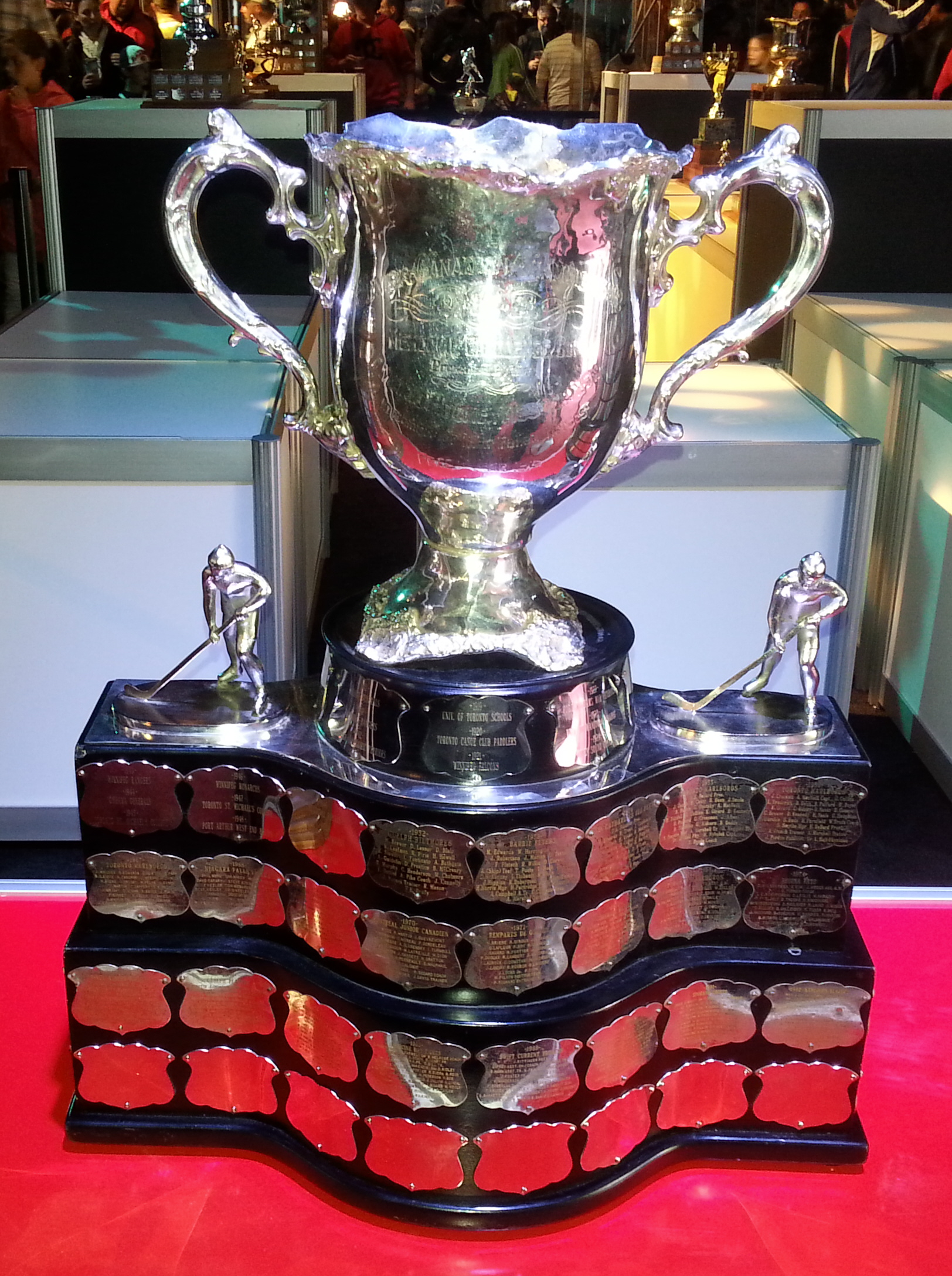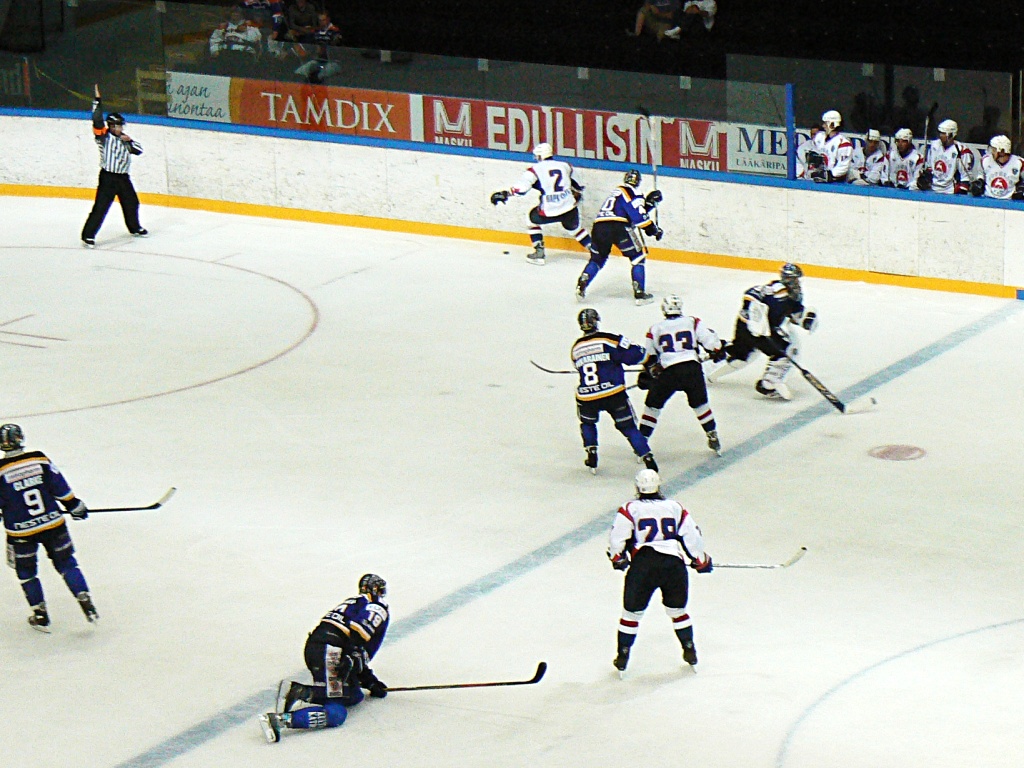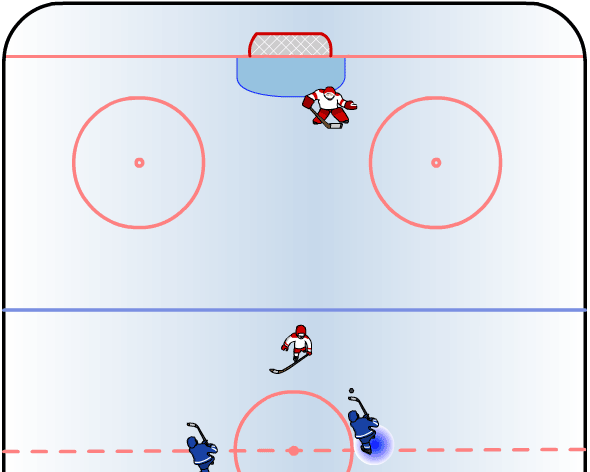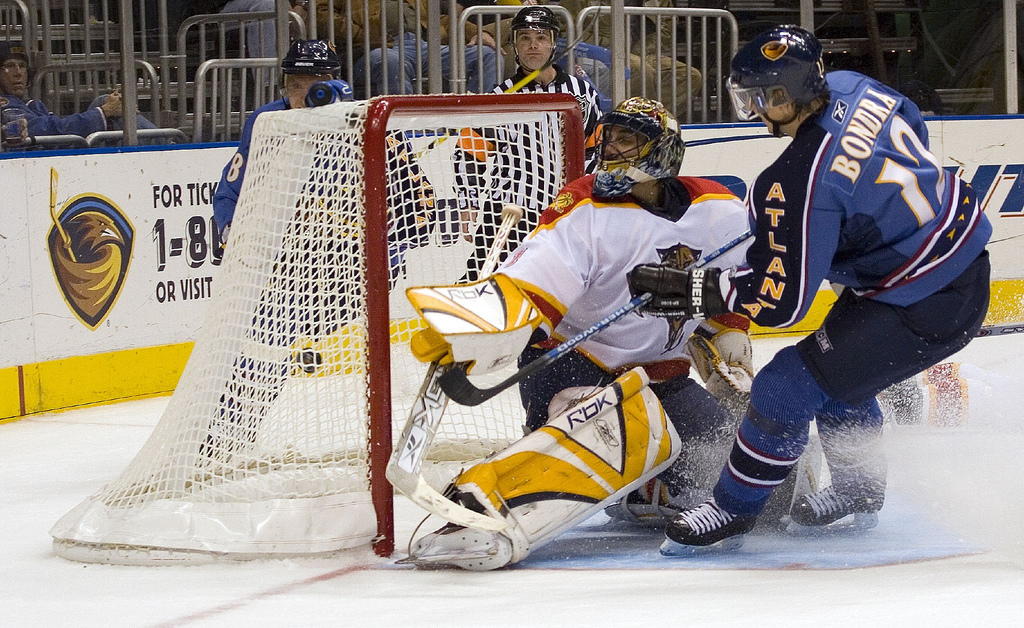|
Ray Gariepy
Raymond Joseph "Rockabye Ray" Gariepy (September 4, 1928 – March 16, 2012) was a Canadian professional ice hockey hard hitting defenceman, who 36 games in the National Hockey League between 1953 and 1956 for the Boston Bruins and Toronto Maple Leafs. Playing career He was raised from an early age in Timmins Ontario, where he first put skate to ice at the age of 14. He was scouted by Hap Emms of the Barrie Flyers, of the OHA Jr. A (from 1945 to 1948), of which Ray was Captain for all 3 years. After Jr. A., Ray played with the Buffalo Bisons AHL, Houston Huskies & Louisville Blades USHL,(1948–49) and Hershey Bears (1950–53) of the AHL. In 1954–55 Ray played for the Pittsburgh Hornets that won the AHL Championship's top prize; The Calder Cup. He finished his professional career with the Toronto Maple Leafs of the National Hockey League in the 1955–56 season after playing one game. Gariepy's lone NHL goal occurred on January 21, 1954 in Boston's 3-2 win over the Black ... [...More Info...] [...Related Items...] OR: [Wikipedia] [Google] [Baidu] |
Defenceman (ice Hockey)
Defence or defense (in American English) in ice hockey Ice hockey (or simply hockey) is a team sport played on ice skates, usually on an Ice rink, ice skating rink with Ice hockey rink, lines and markings specific to the sport. It belongs to a family of sports called hockey. In ice hockey, two o ... is a player position that is primarily responsible for preventing the opposing team from scoring. They are often referred to as defencemen, D, D-men or blueliners (the latter a reference to the blue line in ice hockey which represents the boundary of the offensive zone; defencemen generally position themselves along the line to keep the puck in the zone). They were once called cover-point. In regular play, two defencemen complement three Forward (ice hockey), forwards and a goaltender on the ice. Exceptions include Overtime (ice hockey), overtime during the regular season and when a team is Short-handed, shorthanded (i.e. has been assessed a penalty), in which two defenceme ... [...More Info...] [...Related Items...] OR: [Wikipedia] [Google] [Baidu] |
Calder Cup
The Calder Cup is the trophy awarded annually to the playoff champions of the American Hockey League. It was first presented in 1937 to the Syracuse Stars. The cup is made of sterling silver mounted on a base of Brazilian mahogany. In its current shape, the trophy has a two-tiered square base with commemorative plaques for each of the AHL's 20 most recent champions: 12 on the bottom tier and 8 on the top tier. Each time a new championship plaque is added, the oldest plaque is retired and joins a display at the Hockey Hall of Fame in Toronto. The Hershey Bears have won the Cup more times than any other team, with eleven victories in franchise history. The Cleveland Barons come in second with nine; the Springfield Indians/Kings are third with seven. Eight teams have won back-to-back championships; the Springfield Indians of 1960–62 are the only team to have won three straight Calder Cup championships. On three occasions an AHL club has won the Calder Cup coincidentally w ... [...More Info...] [...Related Items...] OR: [Wikipedia] [Google] [Baidu] |
1948 Memorial Cup
The 1948 Memorial Cup final was the 30th junior ice hockey championship of the Canadian Amateur Hockey Association (CAHA). The George Richardson Memorial Trophy champions Barrie Flyers of the Ontario Hockey Association in Eastern Canada competed against the Abbott Cup champions Port Arthur West End Bruins of the Thunder Bay Junior Hockey League in Western Canada. In a best-of-seven series, held at Maple Leaf Gardens in Toronto, Ontario, Port Arthur won their 1st Memorial Cup, defeating Barrie 4 games to 0. Leadup and finals CAHA president Al Pickard oversaw the playoffs in Western Canada. He supported a resolution where any radio station which broadcast a team's games during the regular season would not pay a premium for the additional playoffs games, and the appointment of Foster Hewitt as the national radio commissioner. Pickard did not want to grant exclusive radio broadcast rights to any station, and the CAHA decided that only out-of-town radio stations would pay a broadca ... [...More Info...] [...Related Items...] OR: [Wikipedia] [Google] [Baidu] |
1947–48 OHA Season
This is a list of OHA standings and season-by-season summaries of the Ontario Hockey Association's Junior A division from 1933 to 1972, and its Tier I division from 1972 to 1974. ;Legend * GP = games played * W = wins * L = losses * T = ties * Pts = points * GF = goals for * GA = goals against 1933–34 The Toronto St. Michael's Majors won the J. Ross Robertson Cup, defeating the Stratford Midgets 2 games to 0. ;Playoffs ''Group Semi-finals'' :London beat Woodstock 3 goals to 2. ::(1-2, 2-0) : Kitchener Empires beat Galt Terrier Pups 5 goals to 4. ::(1-3, 4-1) ''Group Finals'' :Toronto Young Rangers beat Parkdale Canoe Club 13 goals to 3. ::(4-2, 9-1) :Toronto St. Michael's Majors beat Oshawa Majors 2 wins to none, 1 tie. ::(3-3, 8-2, 10-4) :Windsor Wanderers beat London 8 goals to 5. ::(2-0, 6-5) :Stratford Midgets beat Kitchener Empires 11 goals to 9. ::(5-4, 6-5) ''Semi-final'' :Stratford Midgets beat Windsor Wanderers 25 goals to 3. ::(6-2, 19-1) :Toronto St. Michael' ... [...More Info...] [...Related Items...] OR: [Wikipedia] [Google] [Baidu] |
Penalty (ice Hockey)
A penalty in ice hockey is a punishment for an infringement of the rules. Most penalties are enforced by sending the offending player to a penalty box for a set number of minutes. During the penalty the player may not participate in play. Penalties are called and enforced by the referee, or in some cases, the linesman. The offending team may not replace the player on the ice (although there are some exceptions, such as fighting), leaving them short-handed as opposed to full strength. When the opposing team is said to be on a '' power play'', they will have one more player on the ice than the short-handed team. The short-handed team is said to be "on the penalty kill" until the penalty expires and the penalized player returns to play. While standards vary somewhat between leagues, most leagues recognize several common varieties of penalties, as well as common infractions. The statistic used to track penalties is called "penalty minutes" and abbreviated to "PIM" (spoken as singl ... [...More Info...] [...Related Items...] OR: [Wikipedia] [Google] [Baidu] |
Point (ice Hockey)
In ice hockey, point has three contemporary meanings. Personal stat A point is awarded to a player for each goal scored or assist earned. The total number of goals plus assists equals total points. The Art Ross Trophy is awarded to the National Hockey League (NHL) player who leads the league in scoring points at the end of the regular season. Team stat Points are also awarded to assess standings (or rankings). Historically, teams were awarded two points for each win, one point for each tie and no points for a loss. Such a ranking system, implemented primarily to ensure a tie counted as a "half-win" for each team in the standings, is generally regarded as British and/or European in origin and as such adopted by the National Hockey League which was founded in Canada where leagues generally used ranking systems of British origin. Awarding points in the standings contrasts with traditional American ranking systems favored in sports originating within the United States where today th ... [...More Info...] [...Related Items...] OR: [Wikipedia] [Google] [Baidu] |
Assist (ice Hockey)
In ice hockey, an assist is attributed to up to two players of the scoring team who shot, passed or deflected the puck towards the scoring teammate, or touched it in any other way which enabled the goal, meaning that they were "assisting" in the goal. There can be a maximum of two assists per goal. The assists will be awarded in the order of play, with the last player to pass the puck to the goal scorer getting the primary assist and the player who passed it to the primary assister getting the secondary assist. Players who gain an assist will get one point added to their player statistics. Despite the use of the terms "primary assist" and "secondary assist", neither is worth more than the other, and neither is worth more or less than a goal. Assists and goals are added together on a player's scoresheet to display that player's total points. Special cases If a player scores off a rebound given up by a goaltender, assists are still awarded, as long as there is no re-possession by ... [...More Info...] [...Related Items...] OR: [Wikipedia] [Google] [Baidu] |
Goal (ice Hockey)
In ice hockey, a goal is scored when the puck entirely crosses the goal line between the two goal posts and below the goal crossbar. A goal awards one point to the team attacking the goal scored upon, regardless of which team the player who actually deflected the puck into the goal belongs to (see also own goal). Typically, a player on the team attempting to score shoots the puck with their stick towards the goal net opening, and a player on the opposing team called a goaltender tries to block the shot to prevent a goal from being scored against their team. The term goal may also refer to the structure in which goals are scored. The ice hockey goal is rectangular in shape; the front frame of the goal is made of steel tube painted red (blue in the ECHL because of a sponsorship deal with GEICO) and consists of two vertical goalposts and a horizontal crossbar. A net is attached to the back of the frame to catch pucks that enter the goal and also to prevent pucks from entering it ... [...More Info...] [...Related Items...] OR: [Wikipedia] [Google] [Baidu] |
Season (sports)
In an organized sports league, a typical season is the portion of one year in which regulated games of the sport are in session: for example, in Major League Baseball the season lasts approximately from the last week of March to the last week of September. In other team sports, like association football or basketball, it is generally from August or September to May although in some countries - such as Northern Europe or East Asia - the season starts in the spring and finishes in autumn, mainly due to weather conditions encountered during the winter. A year can often be broken up into several distinct sections (sometimes themselves called seasons). These are: a preseason, a series of exhibition games played for training purposes; a regular season, the main period of the league's competition; the postseason, a playoff tournament played against the league's top teams to determine the league's champion; and the offseason, the time when there is no official competition. Preseason ... [...More Info...] [...Related Items...] OR: [Wikipedia] [Google] [Baidu] |
Playoffs
The playoffs, play-offs, postseason or finals of a sports league are a competition played after the regular season by the top competitors to determine the league champion or a similar accolade. Depending on the league, the playoffs may be either a single game, a series of games, or a tournament, and may use a single-elimination system or one of several other different playoff formats. Playoff, in regard to international fixtures, is to qualify or progress to the next round of a competition or tournament. In team sports in the U.S. and Canada, the vast distances and consequent burdens on cross-country travel have led to regional divisions of teams. Generally, during the regular season, teams play more games in their division than outside it, but the league's best teams might not play against each other in the regular season. Therefore, in the postseason a playoff series is organized. Any group-winning team is eligible to participate, and as playoffs became more popular they ... [...More Info...] [...Related Items...] OR: [Wikipedia] [Google] [Baidu] |





